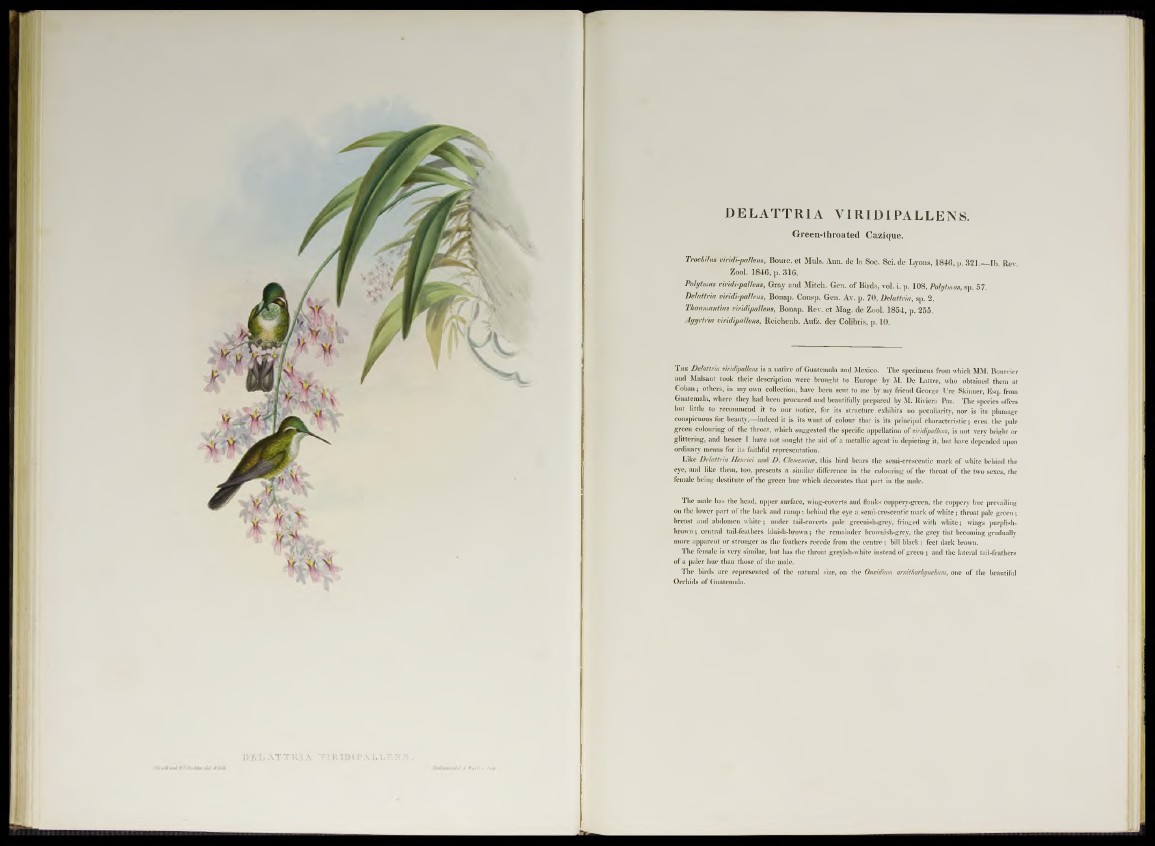
BEL, AT T R I A YLRIBHALLEN S „
A IfaMen lm,
DELATTRIA VIRIDIPALLENS .
Green-throated Cazique.
TrocMlmviridi-pallem, Bourc. et Muls. Aun. de la Soe. Sei. de Lyons, 1846, p. 321.—Ib. Rev.
Zool. 1846, p. 316.
Polytmus viridi-pallem, Gray and Mitch. Gen. of Birds, vol. i. p. 108, Polytmus, sp. 57.
Delattria viridi-pallens, Bonap. Consp. Gen. Av. p. 70, Delattria, sp. 2.
Thaumantias viridipattens, Bonap. Rev. et Mag. de Zool. 1854, p. 255.
Agyrtna viridipallens, Reichenb. Aufz. der Colibris, p. 10.
T he Delattria viridipallens is a native of Guatemala and Mexico. The specimens from which MM. Bourcier
and Mulsant took their description were brought to Europe by M. De Lattre, who obtained them at
Coban; others, in my own collection, have been sent to me by my friend George Ure Skinner, Esq. from
Guatemala, where they had been procured and beautifully prepared by M. Riviera Paz. The species offers
but little to recommend it to our notice, for its structure exhibits no peculiarity, nor is its plumage
conspicuous for beauty,—indeed it is its want of colour that is its principal characteristic; even the pale
green colouring of the throat, which suggested the specific appellation of viridipallens, is not very bright or
glittering, and hence I have not sought the aid of a metallic agent in depicting it, but bave depended upon
ordinary means for its faithful representation.
Like Delattria Henrici and D. Clemencite, this bird bears the semi-crescentic mark of white behind the
eye, and like them, too, presents a similar difference in the colouring of the throat of the two sexes, the
female being destitute of the green hue which decorates that part in the male.
The male lias the head, upper surface, wing-coverts and ilanks coppery-green, the coppery hue prevailing
on the lower part of the back and rump; behind the eye a semi-crescentic mark of white; throat pale green;
breast and abdomen white; under tail-coverts pale greenish-grey, fringed with white; wings purplish-
brown ; central tail-feathers bluish-brown; the remainder brownish-grey, the grey tint becoming gradually
more apparent or stronger as the feathers recede from the centre ; bill black; feet dark brown.
The female is very similar, but has the throat greyish-white instead of green ; and the lateral tail-feathers
of a paler hue than those of the male.
The birds are represented of the natural size, on the Oncidiwn ornithorkynchum, one of the beautifol
Orchids of Guatemala.